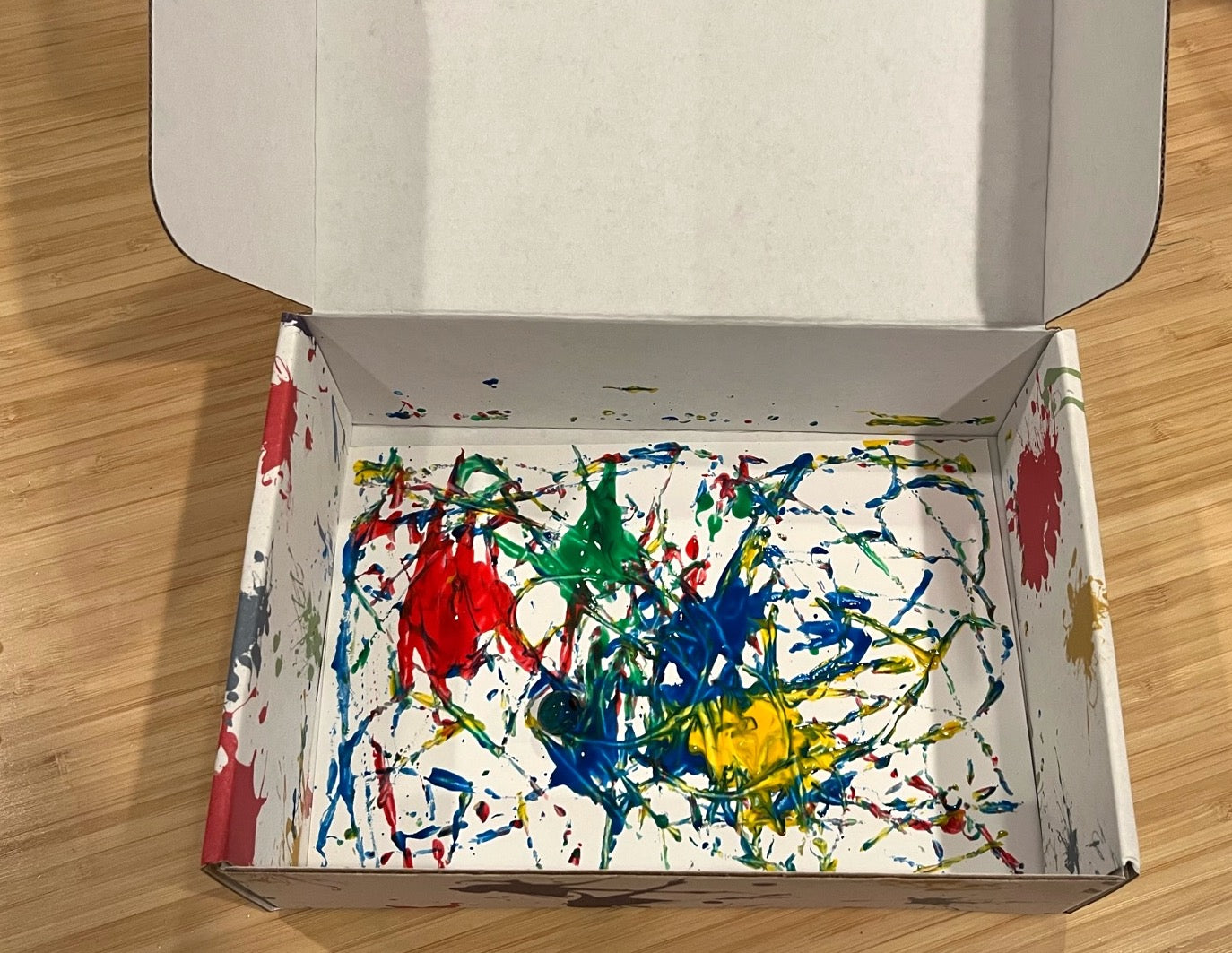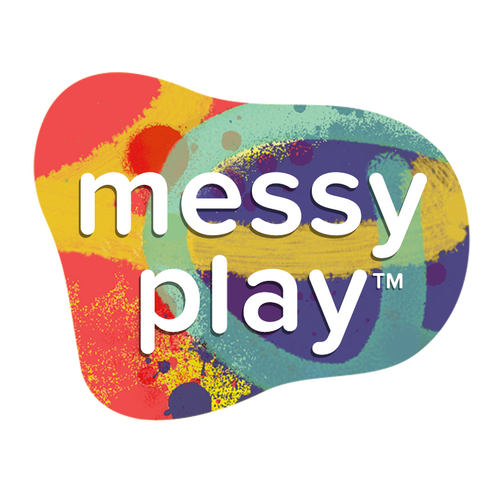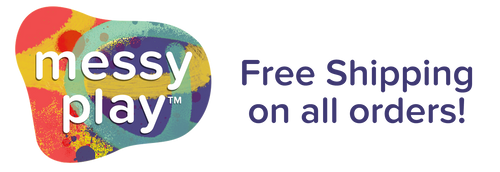

Under the Sea Messy Play Kit Guide

Ready to dig into your Under The Sea Messy Play Kit? On this page you'll find detailed step-by-step instructions, ideas to extend the learning, and some links to other resources. Feel free to reach out if you have any questions about your kit. Now go get messy!
Jump To:
Ocean Bath
Watercolor Corals
Density Experiment
Moonsand Beach
Additional Resources
More Messy Play Kits
Ocean Bath:
1. Divide the waterbeads equally between two large bowls or plastic containers. Be sure you leave enough room for them- each bead will grow to the size of a marble!

2. Add approximately one cup of water and one color tablet to each container of waterbeads. Leave overnight to hydrate, or for at least 6 hours.

As the waterbeads are hydrating, check on them every few hours. What do you notice about the texture? What makes them grow?

3. When the beads are fully hydrated, drain the colored water from the containers and put the waterbeads in the bathtub.

4. Add the fabric seaweed pieces to the tub and enough water to have a fun ocean scene! Bring in the sea creatures and seashells, and any other ocean creature toys you may have (that are water-safe!). You can play with the ocean from outside the tub or climb in carefully!

| Important: The waterbeads should not go down the drain, so be sure to scoop them out before you drain the water. This is challenging but great fine motor practice! Use a strainer or slotted spoon to make it easier. |
If you do climb in the ocean bath, what does it feel like? What do the waterbeads feel like as they slip around your legs? What about the seaweed? Can you collect all the waterbeads in one part of the tub?
What are they learning?
- Science: Material Properties: The waterbeads are very different beforehand after they soak up water. They are tiny and hard before, and larger, more slippery, and squishy afterwards. It only took water for them to be come so different!
- Science: Color Mixing: The waterbeads became the color of the water they soaked up, but as the blue and yellow beads sit in clear water, they begin to lose their color and blend together a bit. What color do you end up with?
- Dramatic Play: You can bring the ocean creatures into the tub with the waterbeads and fabric seaweed, but even without them it’s fun to pretend the tub is an ocean!
- Density: The seaweed floats on top of the water while the waterbeads and animals sink. Why is that?
Watercolor Corals:
1. Place one sheet of art paper onto a tray with an edge- a baking sheet works very well.

2. Carefully cut the tips off of the pipettes containing liquid watercolors, and empty each pipette into a small bowl. Add 1 tablespoon of water per bowl.
3. Using the now-empty pipettes, slowly drip the colors onto the paper, making a fun watercolor artwork. Remember you have three pieces of paper total, so leave some color for the others! Also, if you wet the paper before you add the colors, you get an entirely different effect with the watercolors!


4. Sprinkle a bit of salt on top of the paper. Use both the large salt pieces and the smaller ones.

5. Let the artwork dry, and then brush off the salt to see the watercolor corals you made!


6. Repeat with the remaining two pieces of paper, trying different styles and color combinations. What happens if you let the paint dry a bit more before adding the salt? Do you notice a difference in the effects caused by the larger salt pieces and the smaller ones?
7. One one piece of paper, try adding the salt before you add the watercolors. Does this make a similar effect, or does it do something different? After they dry, can you tell the techniques apart?
What are they learning?
- Science: Why does the salt do that to the color? The salt soaks up some of the liquid, leaving areas without pigment. It works best when the liquid is very wet before the paper soaks it up.
- Fine Motor Control and Impulse Control: Squeezing pipettes great practice for little fingers, and not squeezing all the color out immediately is even more challenging. If they do squeeze it all out at once, you can still continue the experiment- use the pipette to such up some of the color for another piece of paper, or press the papers together to soak up the liquid. Don’t forget to add the salt to see what happens!
- Color Mixing: You’ll make some interesting colors as the orange, turquoise, and lime mix together!
Density Experiment:
1. Open the bag for the Density Experiment that contains the pipette of blue color. Cut off the tip of the pipette, squirt the color into the bag, and add 2 cups of water. Seal the bag while carefully letting as much air escape as possible (might be safest to do over the sink).
2. Place this bag in the freezer overnight.

3. When the first bag is frozen solid, repeat with the second bag (containing the yellow color). Open the pipette, add the color and 2 cups of water, squeeze out the air and seal it shut. Do not freeze this bag.
4. Fill the sink or bathtub with water. Make sure you have at least 5 inches of water. You want enough so you can tell if the bags are sinking or floating.
5. Remove the blue bag from the freezer, and place both bags in the sink/tub. What do you notice? One bag should float while the other sinks lower in the water.
6. Open the yellow bag and watch as the colored water and fish mix into the sink/tub, and then remove the empty bag.
7. Open the blue bag and remove the chunk of ice. Let it mix with the water and slowly melt, mixing the blue and yellow colors together. You can also carefully pick the ice up to look at the magnificent color design inside it, but remember it’s cold!
What are they learning?
- Science: Density: Ice is less dense than water, so it floats on top while the bag with water sinks lower. Things that are more dense have molecules that are more tightly packed together. This means that ice takes up more space than the same amount of water (since it is less dense), and this means that ice expands when it freezes. The bag with ice may look like it contains more than the bag with water, even though we started with the same amount of water in each.
- Density also comes into play with the ice. The liquid watercolors are more dense than water, so they sink to the bottom of the bag in the freezer. The foam fish are less dense, so they float on the top.
- Science: Color Mixing: As the ice slowly melts, you can see the water color go slowly from yellow to green. If you look closely, you’ll see that the water closer to the blue ice is a darker, more blueish green, while the water further away has stayed more yellow.
Moonsand Beach:
1. Pour the bags of cornstarch and sand into a large mixing bowl.
2. Add 1/4 cup of water. You may need more water, but mix this in first and add more if you need.

3. Mix with your hands and enjoy! You should have sand that is easily moldable, but not too wet. The cornstarch helps it stick to itself. (You have created “moonsand!”)

4. Try using the seashells as molds in the moonsand. What else can you do? Can you build a castle? Bring out your own sand toys, or use small plastic containers and measuring cups as molds.

As you play with the moonsand, think about how it is different from regular sand. How is it similar? Can you do the same things with it?What does it feel like as you dig your hands through it?
| TIP: Moonsand will last a long time for playing! If you notice a slightly musty smell at all, spread the sand out thin on a baking tray and bake at a low temperature for a few hours. Then, add water and start over again! |
What are they learning?
- Texture: This sand is a different texture from normal sand. What’s different about it? What’s the same? Is it easier or harder to build something? (Recalling the feel and behavior of regular sand, which is no longer in front of them, is also great practice for children, who tend to focus more on the “here and now.”)
- Fine Motor Control: Mixing the cornstarch and sand together works a lot of muscles in their hands, helping to build strength and coordination. This continues as they pack the sand into molds and squeeze it into shapes.
- Creativity: Work together to build something out of the sand. Maybe make a castle with turrets (vocabulary point!) and a moat, then carve out a drawbridge and large door. Will your castle have windows? Look up photos of other castles and sandcastles if you get stuck, or see what other sand masterpieces you can create. Adults- remember to let the kids lead here- this should be building their creativity, not just yours!
More Ocean Play!
There are so many ways to continue playing with and learning about the ocean. Here are some of my favorites.
- Explore colored bubbles! Artful Kids has a great blog post describing 3 ways to paint with bubbles. Each project gets messier than the last, and they all produce such different results! I have done the first project once, with a slight modification- instead of blowing the bubbles and laying the paper on top to get a print, we blew enough bubbles to overflow from the cup onto the paper, making prints that way. Similar idea and probably a bit messier!
- Make your own ocean waves sensory bottle with instructions from Happy Hooligans. They even have a link to help you explain to your child why oil and water don't mix, and their photos of the bottle are beautiful! Or you can modify it a bit and add some ocean creatures and materials like The Imagination Tree.
- Here's a different spin on a sensory bottle- make your own jellyfish in a bottle! Bhoomplay's Blog has a great writeup and video to show you how easy it is!
- The National Geographic has a great website with videos and information about the ocean, created for classrooms of young children. They start at kindergarten age, so your child may not fully understand all of it, but the site has a lot of great information and it's a good start for helping your child learn about their world!








